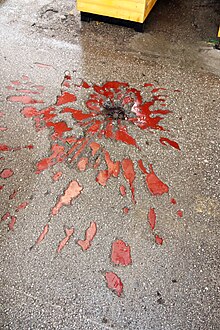Markale massacre

Two incidents during the siege of Sarajevo in the Bosnian War in 1994 and 1995, in which numerous civilians were killed on Markale Square (Pijaca Markale) and its surroundings in Sarajevo, are referred to as the Markale massacre . Soldiers from the Bosnian Serb army ( Vojska Republike Srpske ) are responsible for both massacres . The impact points of the mortar shells are marked today with roses from Sarajevo .
First Markale massacre
The first of the two massacres took place around noon on February 5, 1994, when a 120 mm mortar projectile detonated on Markale Square in central Sarajevo ( ). 68 civilians died and 144 others were injured. The incident in the zone under UN protection led to an ultimatum from the UN Security Council to the Bosnian Serb Army (VRS) to withdraw all heavy weapons and mortar guns from a 20-kilometer radius of the city within ten days Supervision of UNPROFOR .
![]()
The incident was the subject of proceedings against Stanislav Galić , then commander of the Sarajevo Romanija Corps of the VRS, before the International Criminal Tribunal for the former Yugoslavia (ICTY), which led to his sentencing in 2003 to 20 years imprisonment (later extended to life).
Second Markale massacre
The second incident occurred on August 28, 1995. A 120 mm mortar shell struck the street leading past the market ( ), and five more hit the National Theater. 37 people were killed and 90 others were injured (according to other information: 43 dead and 89 injured). The then UNPROFOR commander for Bosnia, General Rupert Smith , stated in his report to the UN Security Council that the grenades had undoubtedly been fired from the districts of Trebević and Lukavica held by the VRS. Two days later, NATO began Operation Deliberate Force against the VRS.
![]()
The commander of the VRS Sarajevo Romanja Corps at the time of the incident, General Dragomir Milošević , was sentenced to 33 years imprisonment by the ICTY for war crimes during the siege of Sarajevo in December 2007.
See also
Individual evidence
- ↑ ICTY judgment against STANISLAV GALIĆ (PDF; 1.1 MB).
- ↑ ICTY judgment against DRAGOMIR MILOŠEVIĆ (PDF; 683 kB).

